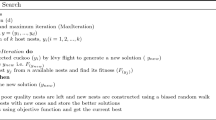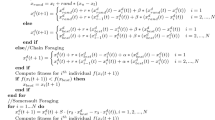Abstract
Spotted hyena optimizer (SHO) is a recently developed metaheuristic technique that mimics the hunting behavior of the spotted hyenas. However, it does not provide optimal solution for discrete problems. Therefore, a novel binary version of Spotted Hyena Optimizer is proposed in this paper. The binary version of SHO can deal with discrete optimization problems. In the proposed algorithm, tangent hyperbolic function is utilized to squash the continuous position and then these values are used to update the position of spotted hyenas. The prey searching, encircling, and attacking are three main steps of binary spotted hyena optimizer. The proposed algorithm has been compared with six well-known metaheuristic techniques over 29 benchmark test functions. The effects of convergence, scalability, and control parameters have been investigated. The statistical significance of the proposed approach has also been examined through ANOVA test. The proposed approach is also applied on feature selection domain. The performance of proposed approach has been compared with four well-known metaheuristic techniques over eleven UCI repository datasets. The experimental results reveal that the proposed approach is able to search the optimal feature set than the others.









Similar content being viewed by others
References
Bonabeau E, Dorigo M, Theraulaz G (1999) Swarm intelligence: from natural to artificial system. Oxford University Press, Inc, Oxford
Chandrashekar G, Sahin F (2014) A survey on feature selection methods. Comput Electr Eng 40(1):16–28
Chizi B, Rokach L, Maimon O (2009) A survey of feature selection techniques, encyclopedia of data warehousing and mining, 2nd edn. IGI Global, Hershey, pp 1888–1895
Chuang LY, Chang HW, Tu CJ, Yang CH (2008) Improved binary PSO for feature selection using gene expression data. Comput Biol Chem 32:29–38
Dhiman G, Kumar V (2017) Spotted hyena optimizer: a novel bio-inspired based metaheuristic technique for engineering applications. Adv Eng Softw 1144:48–70
Digalakis J, Margaritis K (2001) On benchmarking functions for genetic algorithms. Int J Comput Math 77(4):481–506
Dorigo M, Birattari M, Stutzle T (2006) Ant colony optimization—artificial ants as a computational intelligence technique. IEEE Comput Intell Mag 1:28–39
Emary E, Zawbaa HM, Hassanien AE (2016) Binary grey wolf optimization approaches for feature selection. Neurocomputing 172:371–381
Falcon R, Almeida M, Nayak A (2011) Fault identification with binary adaptive fireflies in parallel and distributed systems. In: IEEE congress on evolutionary computation, pp 1359–1366
Firpi HA, Goodman E (2004) Swarmed feature selection. In: Proceedings of 33rd IEEE workshop on applied imagery pattern recognition, Washington, DC, pp 112–118
Frank A, Asuncion A (2010) UCI machine learning repository. http://archive.ics.uci.edu. Accessed 01 Jan 2019
Ilany A, Booms AS, Holekamp KE (2015) Social network dynamic in a wild animal. Ecol Lett 18(7):687–695
Kennedy J, Eberhart RC (1995) Particle swarm optimization. In: Proceedings of IEEE international conference on neural networks, pp 1942–1948
Kennedy J, Eberhart RC (1997) A discrete binary version of the particle swarm algorithm. In: IEEE international conference on computational cybernetics and simulation, Orlando, pp 4104–4108
Kumar V, Kumar D (2018) Binary whale optimization algorithm and its application to unit commitment problem. Neural Comput Appl 2018:1–29
Kumar V, Minz S (2014) Feature selection: a literature review. Smart Comput Rev 4(3):1–10
Liang JJ, Suganthan PN, Deb K (2005) Novel composition test functions for numerical global optimization. In: Proceedings of IEEE swarm intelligence symposium, pp 68–75
Mirjalili S (2016) Dragonfly algorithm: a new meta-heuristic optimization technique for solving single-objective, discrete, and multi-objective problems. Neural Comput Appl 27(4):1053–1073
Nakamura RYM, Pereira LAM, Costa KA, Rodrigues D, Papa JP, Yang XS (2012) BBA: a binary bat algorithm for feature selection. In: IEEE conference on graphics, patterns and images, pp 291–297
Ramos CCO, Souza AN, Chiachia G, Falcao AX, Papa JP (2011) A novel algorithm for feature selection using harmony search and its application for nontechnical losses detection. Comput Electr Eng 37(6):886–894
Rashedi E, Nezamabadi-pour H, Saryazdi S (2009a) GSA: a gravitational search algorithm. Inf Sci 179(13):2232–2248
Rashedi E, Nezamabadi-pour H, Saryazdi S (2009b) BGSA: binary gravitational search algorithm. Nat Comput 9:727–745
Rodrigues D, Pereira LAM, Pappa JP, Ramos CCO, Souza AN, Papa LP (2013a) Optimization feature selection through binary charged system search. In: Proceeding of 15th international conference on computer analysis of images and patterns, pp 377–384
Rodrigues D, Pereira LAM, Almeida TNS, Papa JP, Souza AN, Ramos CCO, Yang XS (2013b) A binary cuckoo search algorithm for feature selection. In: Proceedings of IEEE international symposium on circuits and system, pp 4465–468
Srinivasa KG, Venugopal KR, Patnaik LM (2007) A self-adaptive migration model genetic algorithm for data mining applications. Inf Sci 177(20):4295–4313
Storn R, Price K (1997) Differential evolution—a simple and efficient heuristic for global optimization over continuous spaces. J Glob Optim 11(4):341–359
Yang X (2010) Firefly algorithm, stochastic test functions and design optimization. Int J Bio-Inspired Comput 2(2):78–84
Yu L, Liu H (2004) Efficient feature selection via analysis of relevance and redundancy. J Mach Learn Res 5:1205–1224
Author information
Authors and Affiliations
Corresponding author
Additional information
Publisher's Note
Springer Nature remains neutral with regard to jurisdictional claims in published maps and institutional affiliations.
Rights and permissions
About this article
Cite this article
Kumar, V., Kaur, A. Binary spotted hyena optimizer and its application to feature selection. J Ambient Intell Human Comput 11, 2625–2645 (2020). https://doi.org/10.1007/s12652-019-01324-z
Received:
Accepted:
Published:
Issue Date:
DOI: https://doi.org/10.1007/s12652-019-01324-z




